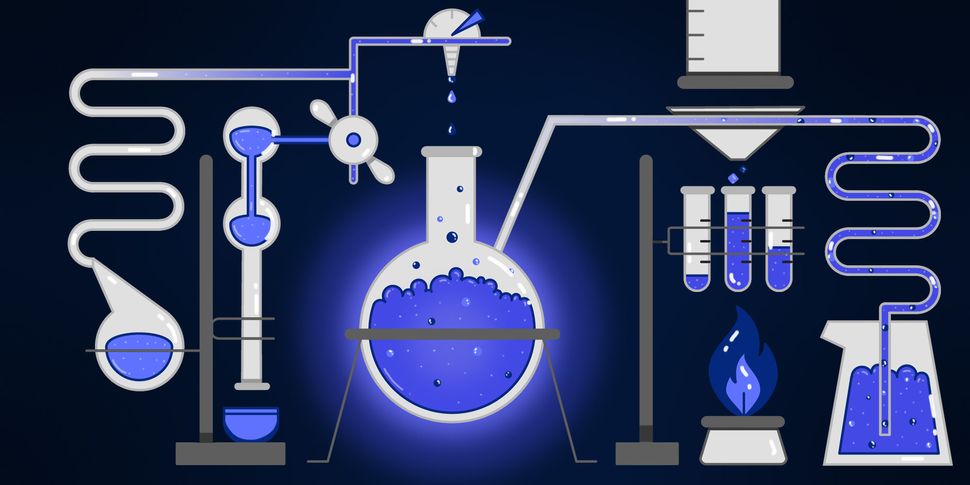
BERKELEY, Calif. ― There are no windows in the underground laboratory at the University of California, Berkeley’s Hildebrand Hall. No portals through which to see the sky. The bluest things in sight are the cobalt-colored lab coats worn by two chemists huddled around a beaker of white viscous liquid, its temperature slowly climbing.
On a Monday afternoon in August, the blue-coat technicians watched the liquid with a spellbound intensity. Their resident leader, a woman named Olga Alexopoulou, was positioned in an adjacent room the size of a small walk-in closet, illuminated only by the phantom glow of ultraviolet light.
Inside, she slowly peeled back a sheet of aluminum foil to reveal four glass microscope slides, a globule of liquid the size of a thumbprint on each. Like alien droppings, they glowed underneath the UV bulbs with a cinematic ferocity.
“The average person has never seen this kind of purity of color,” Alexopoulou told me.
Alexopoulou isn’t a scientist. She’s an artist. But, inside the tiny lab in Berkeley, shaded from the unceasing clamor of the world outside, she and her methodologically-inclined counterparts are on the same curious quest: They are attempting to engineer a new pigment of blue.
Over the course of 10 months, Alexopoulou has project-managed her secretive team from Istanbul, communicating through email and Skype to check up on the mysterious liquid. According to Alexopoulou, the blue she’s after is different than all the man-made blues that have come before it. Hers is “the blue of the future,” a pigment that dazzles in its sheer purity and depth, emitting a radiance more often associated with neon lights than the contents of a tube of paint.
With an undeniable weight of seriousness, Alexopoulou has dubbed her pigment Quantum Blue.
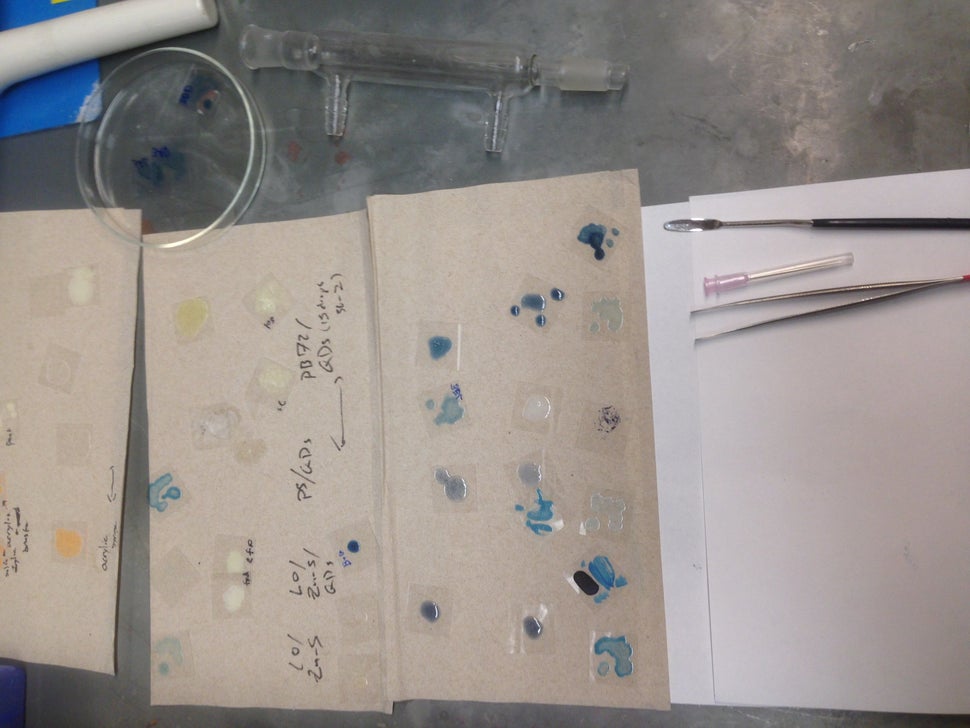
Humanity’s fascination with blue predates Alexopoulou by millennia. Blue pigments rarely occur in nature, and many of the blues that do exist ― a bird’s plume, a butterfly wing ― appear that way due to optical illusions that have evolved over time. Humans, enamored by these fleeting hues, have long been eager to harness them.
Five-thousand years ago, craftsmen created what’s thought to be the first artificial pigment, Egyptian Blue, by mixing limestone, sand and azurite. This is the usual form a pigment takes, a dry powder substance that, when mixed with a liquid or other medium, constitutes a paint or ink. Later came ultramarine, ground from the semi-precious stone lapis lazuli, sourced from a particular mountain range in Afghanistan for centuries. The ultra-expensive pigment was primarily reserved for representations of the Virgin Mary’s holy robes.
In the 17th century, indigo, a natural dye, became a hot commodity import across Europe and Asia, despite its tendency to dim over time. In the 18th century, an alchemical accident became an artistic miracle when a paint maker’s contaminated potash turned his potion from cochineal red to the melancholic tone known as Prussian Blue. It’s the stuff of Hokusai’s “The Great Wave off Kanagawa” and Pablo Picasso’s Blue Period.
French artist and blue soothsayer Yves Klein crafted his very own International Klein Blue (IKB) in 1960, collaborating with paint supplier Edouard Adam to yield a paint formula that protected the intensity of its ultramarine pigment base through a synthetic resin binder. He coated canvases with his titular hue, which, according to curator Kerry Brougher, “seemingly [opened them] up to immaterial realms.” It now adorns the bald heads that comprise The Blue Man Group.
Then, in 2009, chemist Mas Subramanian accidentally concocted YInMn blue by fusing yttrium, indium oxide and manganese. The resulting pigment, considered the first new complex inorganic blue to be commercially manufactured since cobalt 200 years before it, absorbs red and green light waves while reflecting a “superblue” both vivid and durable. Crayola’s newest crayon flavor, Bluetiful, is based off the shade.
Alexopoulou, whose work is represented in Turkey by the gallery Istanbul Concept, is well versed in the landmark events of blue’s past. As a painter, she often incorporates the traditional recipes for Prussian Blue and Ultramarine in the gestural seascapes or street art murals she creates. In 2011, she traveled to Jingdezhen, China, to study the 14th-century technique of painting ceramics with cobalt blue pigments.
Blue is the common thread that weaves Alexopoulou’s fine art career together, the itchy obsession that keeps drawing her back.
With Quantum Blue, Alexopoulou shifts her attention from blue’s history to its future. Her ultimate goal is to create a new pigment accessible to artists like her ― not just industrial manufacturers, the target audience for YInMn. By doing so, she hopes to cement herself and her creation as “a part of the history of art,” she said.
For now, however, the pigment remains tucked inside an underground lab, its physical isolation mirroring the overall project’s detachment from the more chaotic concerns of today. Droplet by droplet, the pigment comes into being, and, at least for now, remains quarantined in total darkness.

At a Korean fusion restaurant in Berkeley, Alexopoulou, 38, her dark hair tied tightly in a ponytail, discussed the origins of her Quantum Blue project between bites of grilled vegetable salad. It was the first week of the university’s fall semester, and the joint was buzzing with the excited murmurings of students back from summer vacation.
Across from Alexopoulou sat color historian Maria Chatzidakis, whose dark bob was accentuated by two strips of white hair framing her face. Next to her sat Arunima Balan and Joseph Swabeck, both fifth-year Ph.D. chemistry students at UC Berkeley.
Quantum Blue isn’t entirely novel, Alexopoulou and her brigade of blue disciples explained to me over dinner. Humans have encountered hues like it before; think blue morpho butterflies, whose wings glow iridescent with the help of microscopic scales. Or the period of a day known as the blue hour; that brief twilight before sunrise or after sunset, when the sun hovers significantly below the horizon and indirect sunlight casts a fluorescent blue blanket across the sky.
Alexopoulou, who grew up in Athens and summered on the Greek isles, spent countless evenings transfixed by those moments at dusk when sea and sky looked like they’d been plugged into an electric socket. Up until now, only nature had the power to conjure such a sublime glow, she said.
So what Alexopoulou and her team sought to do is channel the effect through a pigment that’s both reliable and reproducible, allowing artists to represent the most bewitching nature-made blues with unprecedented integrity.
For the scientists involved, Quantum Blue offered the rare shot to introduce nanoscientific principles to a larger audience in a digestible way. While Alexopoulou’s motives are romantic, Swabeck and Balan’s veer toward the utilitarian: They are trying to market their research in the most effective way possible.
“People can relate to art,” Balan said. “People cannot relate to quantum dots.”
Together, Alexopoulou and her team hope to patent their creation, getting in on the $30 billion pigment industry and expanding the quantum dot paint process to include the other colors of the rainbow.
“If we can make it work with blue, we can make it work with anything,” Swabeck said.

It wasn’t until 2017 that Alexopoulou’s project began to take shape. She was at a dinner party when she overheard a fellow guest, a professor, discussing quantum dots ― nanoscopic crystals that emit color with a startling intensity. Her ears perked up. After years of researching the most potent blues that art and science had to offer, Alexopoulou had a premonition of creating her own. Was nanoscience the unlikely answer to her artistic dream?
Quantum dots are extremely tiny particles of semiconducting material, 10,000 times narrower than a human hair. Because of their diminutive size ― only a few nanometers across ― quantum dots have the unique ability to convert light into color with striking efficiency and force. The effect is fluorescent, just like “the blue hour.”
Quantum dots are frequently used in biomedicine to tag and track particular cells in the body like teeny tiny post-its. However, they’ve recently gone more mainstream thanks to Samsung’s high-end quantum dot televisions, billed to project images so vibrant they yield an experience akin to “watching real life on your TV.”
Alexopoulou had an idea: What if she could use these buzzy, scientific particles for her own artistic purposes? What if she could create the first pigment out of quantum dots?

The sky was white the day I visited the lab, making every blue detail on campus pop like a rare gem: The cobalt logo on a USPS truck, the turquoise recycling cans lining the sidewalk, the cerulean stripes on a bro’s plaid shirt.
Inside the windowless basement of Hildebrand Hall, we wore safety goggles at all times and were carefully instructed to not lean on anything, as every surface in the lab is considered to be contaminated. Signs reading “DANGER” adorned the walls and a ceiling shower-head offered instant, aqueous relief in case of emergency. It seemed the mission to create a new blue wasn’t just a scientifically demanding mission, but a potentially life-threatening one.
“When we do chemistry, we spend a lot of time thinking about how to not die,” Swabeck explained.
The lab was built in 1966 and has been accruing random leftovers of the scientific experiments conducted within it ever since. “Things don’t change in a lab,” Swabeck corroborated. “It’s basically a slow accumulation of stuff.” Shelves overflowed with vials, beakers and bottles of chemicals turned sepia with age. Glass panes and open counters were cluttered with handwritten chemical formulas and the occasional doodle. The space ― akin to a secret testing facility on “Stranger Things” ― felt almost too nostalgic and campy to be real.
The lab is Swabeck and Balan’s terrain. Underground, they said, it’s easy to lose track of time; they often arrive before sunrise and leave after sunset, missing daylight completely. Without phone or internet access, they’re cut off from human contact and current events, focusing solely on matters of the most elemental variety. They’ve also gotten really good at crossword puzzles.
“They are on a path that can be a hard and lonely one, learning how to create new knowledge,” Paul Alivisatos, UC Berkeley’s Samsung distinguished professor of nanoscience and nanotechnology, told HuffPost.
Alivisatos is the fairy godfather looming over Quantum Blue’s creation myth. Alexopoulou emailed him shortly after the 2017 dinner party, explaining her idea. Alivisatos, a sucker for art-meets-science hybrid projects, said yes. “There are really deep connections between what happens when we invent new material ― particularly one that affects color and how we perceive it ― and what’s possible with artistic expression,” Alivisatos said.
“Those things should be connected together more than they are.”
A hugely influential figure in the nanoscience community, Alivisatos assigned Balan and Swabeck ― his students ― to assist Alexopoulou on her task. He also offered up his lab and all its resources for the cause, essentially relieving the pigment-concocting process of its monetary costs.
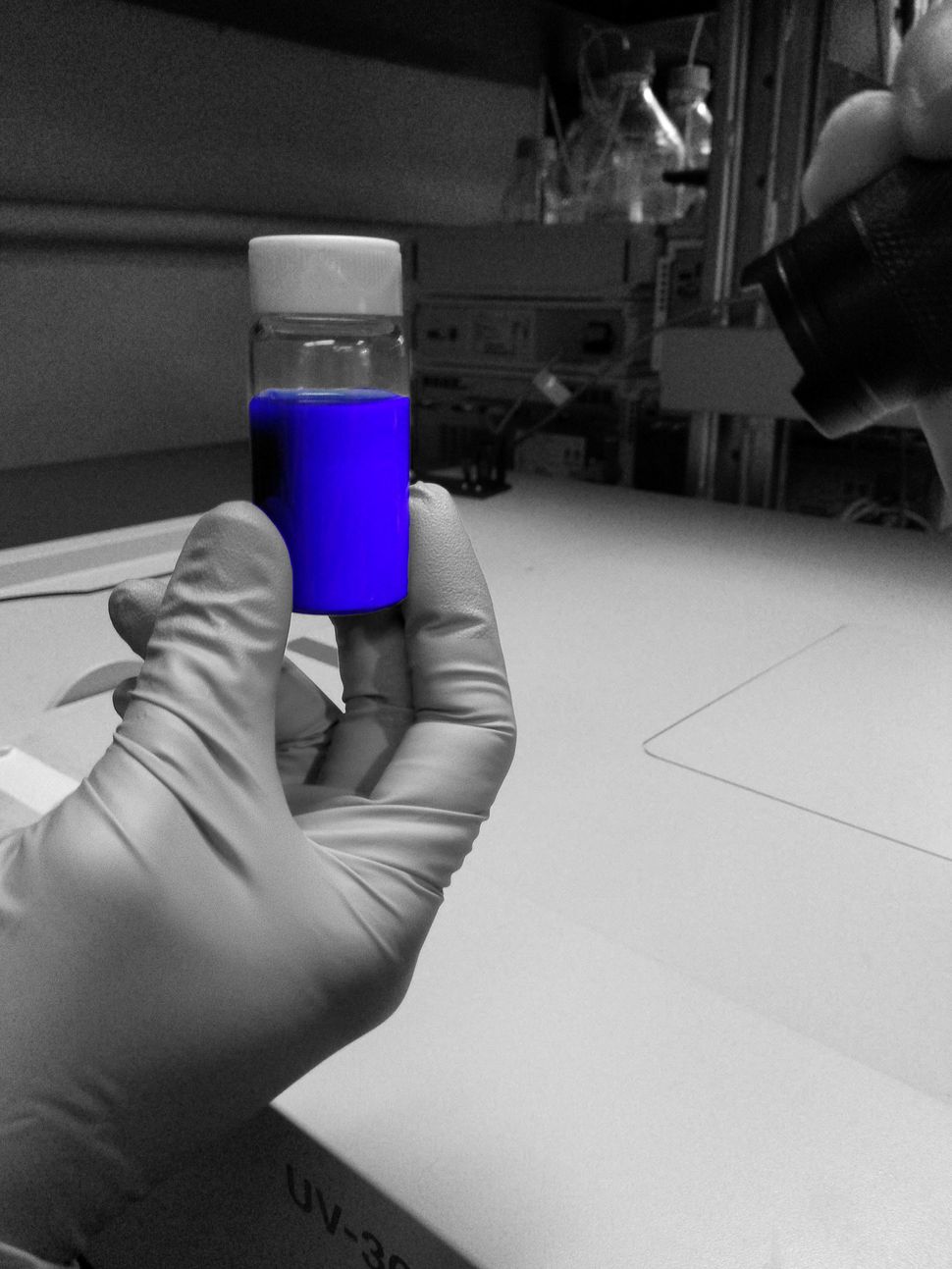
Dressed appropriately in blue lab coats, Swabeck and Balan prepared the quantum dots, executing a procedure they’d completed hundreds of times throughout their grad school experiences.
A row of oversized black rubber gloves protruded, ghostlike, from enclosed hubs whose reactive contents couldn’t touch open air. Balan stuck her hands inside two of the gloves and into the glass box, mixing metal salts in organic solvents with the impaired dexterity of Frankenstein’s monster baking in oven mitts.
Balan then brought the potion over to a fume hood and set the liquid ― contained in a round-bottom beaker ― to heat to 300 C. The team huddled around for an admittedly anticlimactic glimpse of the whitish liquid in action. “A watched cad never complexes!” Balan joked, shooing the onlookers away. Eventually the temperature peaked and Balan injected elemental sulfur into the brew. After a brief waiting period, one more sulfur injection, and then... a lunch break.
The process of concocting a perfect blue required painstaking accuracy at every step.
Swabeck and Balan have methodically refined the hue over the past year, sending Alexopoulou photographs of their samples along the way. “Too much purple,” she responded one day. “Too much cyan,” another. Alexopoulou is queen bee, remotely nudging her workers in the right direction. Together they inched closer to zeroing in on a blue that would look just right.
In employing nanoscience for artistic means, Alexopoulou and her team are continuing a tradition that extends back to the 10th century. Stained glass artisans unwittingly discovered that adding gold chloride to molten glass yielded a brilliant red tone. Similarly, silver nitrate produced a vibrant yellow. Centuries later, scientists analyzing medieval stained glassworks realized that the gold and silver nanocrystals were, in fact, acting as quantum dots.
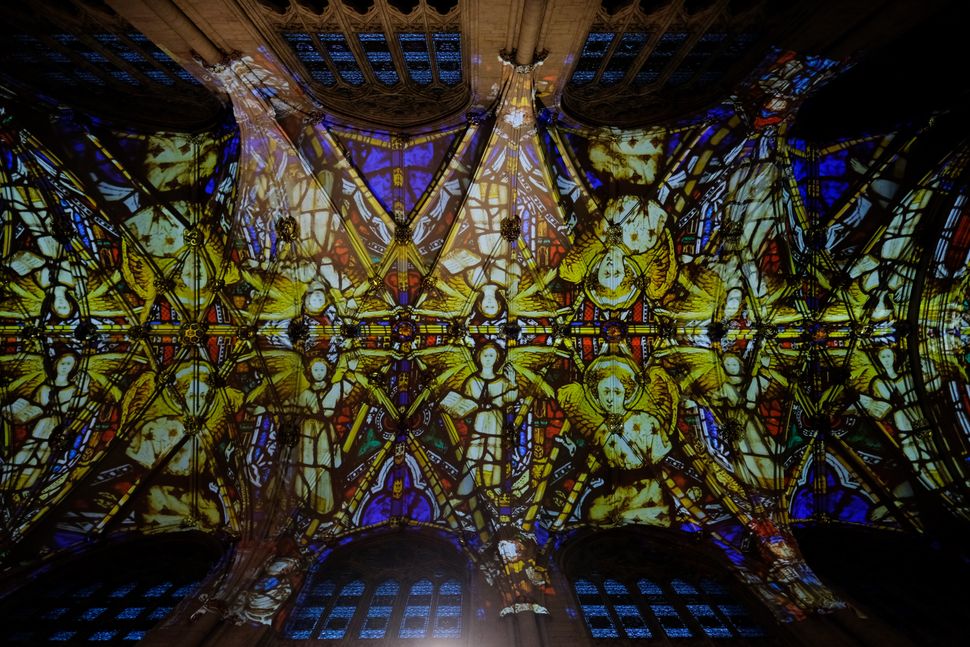
Though it’s the nanocrystals that provide Quantum Blue’s vibrant tone, the true innovation resides in the binding agent holding them together.
In other pigments, sticky substances like egg yolks, resin and oil serve as the glue that truly turns colored fragments into paint. For Klein too, finding a binder that would protect the vibrancy of his color was the paramount challenge. In Alexopoulou’s case, she needed a binder that would give the quantum dots a paint-like texture without dampening the intensity of the blue.
Chatzidakis, the most soft-spoken member of the team, is in charge of this pivotal concoction. A conservator, lecturer and color historian, Chatzidakis is an expert in the recipes of historical hues. Yet Quantum Blue presented a new challenge, something “like science fiction,” she said. It was the chance to create a blueprint, instead of studying a preexisting one.
Alexopoulou, Chatzidakis, Swabeck and Balan all refused to discuss the contents of the evasive binding agent. This is, effectively, where the money is.
Pigments have become an unexpectedly active pocket of the art world, thanks to recent technological advancements in chemistry and physics. “Labs now have the ability to control matter on very tiny scales,” Alivisatos said. “And that allows us to control what the overall experience of interacting with light is like in a way that was not easy to do before.”
Members of the art world have taken note. In 2014, five years after the surprising creation of YInMn blue, Surrey NanoSystems introduced Vantablack ― reportedly the darkest artificial substance ever created. Made using vertically aligned nanotubes, the black is “so black that it makes reality look Photoshopped.” In 2016, British sculptor Anish Kapoor controversially won exclusive rights to use Vantablack in an artistic context, a move which riled up his peers. In response, artist Stuart Semple created what he dubbed the world’s pinkest pink and made it available to all artists ― except Kapoor.
Quantum Blue might be the next major development in the race for the next big pigment. However, YinMn blue creator Subramanian, a professor at Oregon State University, expressed skepticism at the colorant being defined as such.
“I think what they are trying to do is to take quantum dots and embed them in a certain material, so it can be used in art,” Subramanian told HuffPost, noting that he couldn’t come to final conclusions without knowing more about the chemistry involved. “When we discovered a new pigment — YinMn Blue — it was a totally new chemical compound.
“Still, it’s a fascinating concept.”
When asked if he was worried about any potential competition with his own blue hue, Subramanian said, “I’m not worried about that.” In part, this is because Quantum Blue needs a UV light to activate its tone; in daylight, it appears yellowish white, meaning artworks featuring the paint must be exhibited in the dark. YinMn blue, on the other hand looks blue in any environment. “You can see [it] under a visible light, for example, sunlight.”
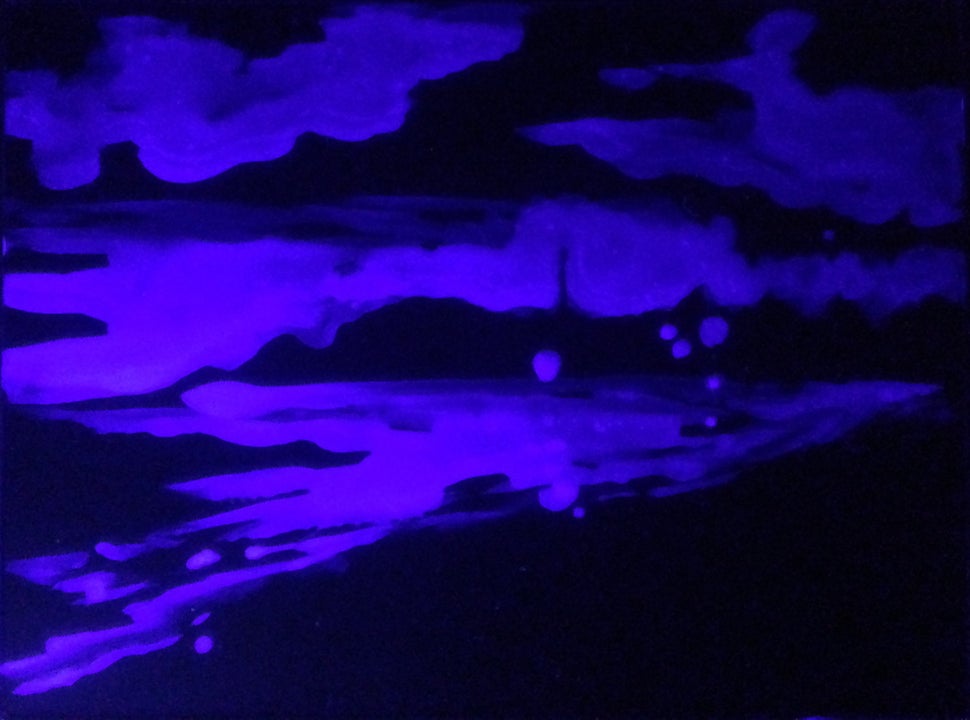
On the last day of August, Alexopoulou created her first painting using Quantum Blue. Rendered on a 15-by-20-centimeter glass canvas, it depicts a beach on the Greek island of Aegna during twilight, the blue hour, she said. The piece is certainly “abstract,” as Alexopoulou described it, featuring only a few gestural brushstrokes to represent the clouds and cresting waves.
The piece ― created in under two hours ― doesn’t photograph well, in part due to Quantum Blue’s ethereal intensity, which is difficult to accurately capture on film. The seascape isn’t likely to transport your psyche to a remote Greek isle anytime soon, but Alexopoulou’s medium was bound to be more intriguing than her final product.
After its completion, the quantum seascape was packed up and put in storage, where it will lie dormant until its public debut at Tokyo’s UltraSuperNew Gallery next March. Until then, the glass sheet will stay “confined in darkness,” as Alexopoulou put it, to protect the pigment’s luster.
Perhaps one day, Quantum Blue will be as readily available in art stores as navy or cerulean. Or maybe it will remain in the purview of elite artists who can pay the right price. Either way, it might only be a matter of time before Quantum Red and Yellow follow in Blue’s footsteps. For now, the sole manifestation of Quantum Blue lives where no one can see it.
Right now, Alexopoulou said she’s in the early stages of patenting the creation, beginning a process that could take months. She intends to reach out to manufacturers and distributors to discuss next steps, though she refused to provide details due to “complicated legalities.” Regardless of the future, Alexopoulou felt the experiment was a success when she saw the little vial radiating blue.
What’s the good of a new color if no one is there to see it? Blue’s earthly scarcity has always contributed to its mystique, its perceived spirituality and magnetic force. According to Johann Wolfgang von Goethe, blue has “a peculiar and almost indescribable effect on the eye.” Writer William Gass dubbed the shade the “color of interior life.”
“Blue is always under a mystery veil,” Chatzidakis said.
Quantum Blue may be an unprecedented color, but its creation perpetuates an artistic tradition as old as the landscape or the nude: The eternal stumbling towards a newer, deeper, bluer blue. Klein said the color, like the sea and sky it stains, is “beyond dimensions.” It appears our human desire for blue in all its elusive glory is just as boundless.
“We love to contemplate blue,” Goethe wrote in 1810, “not because it advances to us, but because it draws us after it.”
Who would have thought the poetic statement would manifest itself so literally? If only the 19th-century statesman could see the scene that unfolded deep underground that August East Bay morning. Lab coats and goggles and bubbling stews, a mission at once incredibly niche and impossibly zealous. Taking a page from the butterflies’ book, fabricating and harnessing an utterly new blue ― again.